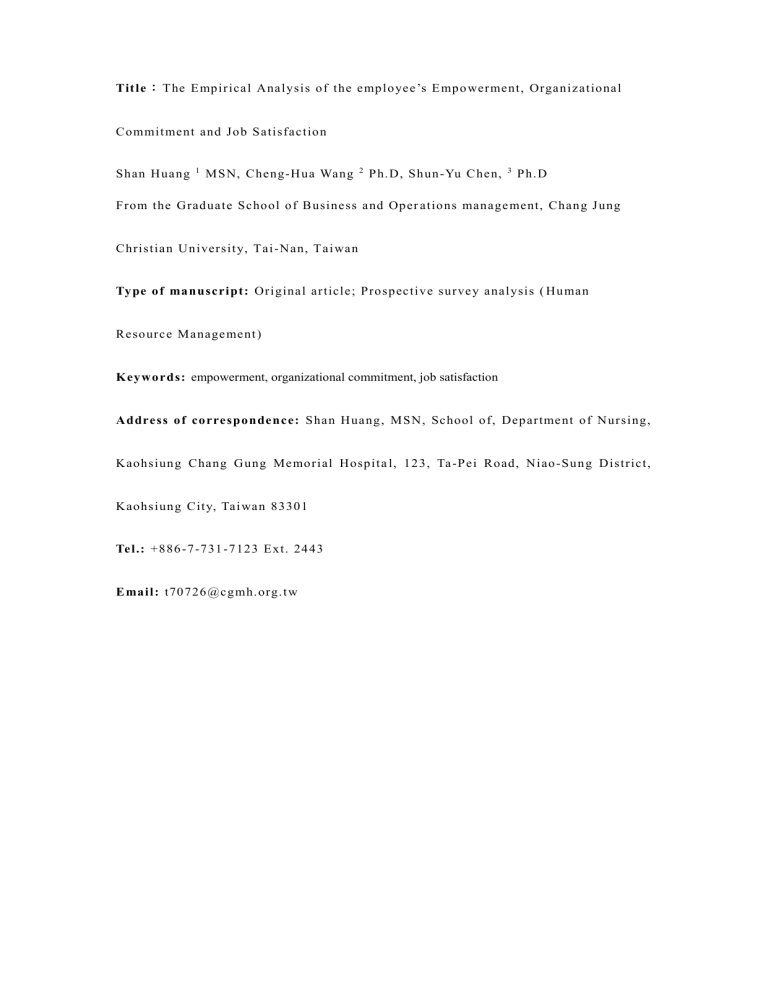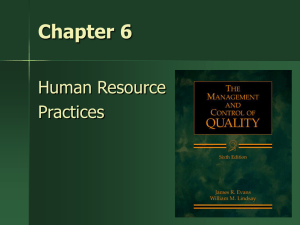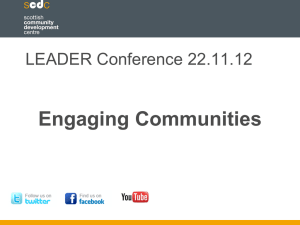Empowerment, Organizational Commitment, and Job Satisfaction in

Tit l e : T he E mp i r i ca l A na l ys i s o f t he e mp l o ye e ’s E mp o we r me nt , Orga ni z a t io na l
C o mmi t me nt a nd J o b S a t i s fa c t io n
S ha n H ua ng 1 M S N, C he ng -H ua Wa ng 2 P h. D , S h un -Yu C he n, 3 P h. D
F ro m t he G r ad ua t e S c ho ol o f B us i ne s s a nd Op er a t io ns ma na ge me nt , C ha n g J ung
C hr i s t i a n U n i ver s i t y, T a i -N a n, T a i wa n
Ty pe o f ma n u s c r i p t: Or i gi na l a r t ic l e ; P ro s p ec t i v e s ur ve y a na l ys i s ( H u ma n
R e s o ur c e M a na ge me nt )
Ke yw o r d s: empowerment, organizational commitment, job satisfaction
A d dre s s o f co rre s p o n de n c e: S ha n H ua ng , M S N , Sc hoo l o f, De p ar t me nt o f N ur s i ng ,
K ao hs i un g C ha ng G ung M e mo r i al H o sp i t a l, 12 3, Ta -P e i R oa d, N i ao -S u n g D i s t r ic t ,
K ao hs i un g C i t y, Ta i wa n 833 01
Te l .: +88 6 -7 -7 31 -7 123 E xt . 24 43
E ma i l : t70 726 @c g mh. org. t w
ABSTRACT
I n tro d u c ti o n : Clinical nurses are in the front line at hospitals, they also are the most indispensable care resources at all the time. The study is to build up the environment for nurses to develop their potential on nursing professional, to promote the development of the nursing roles and functions, and thus to improve nurses’ job satisfaction.
M et ho d s : This is a cross-sectional study using a convenience sampling. Data were collected from two medical centers, two regional hospitals, and two district hospitals. In total, 446 nurses participated in the study.
R e s u lt s : The findings showed that: (a) there are positive correlations between empowerment and organizational commitment, empowerment and job satisfaction, and organizational commitment and job satisfaction; (b) the reciprocity of empowerment, the ownership, the synergy of empowerment, and the seniority of the organization are effective predictors, which explain 38.8% of the total variance in organizational commitment; and (c) strive commitment, empowerment reciprocity, empowerment ownership, and value commitment are effective predictors, which explain 59% of the total variance in job satisfaction.
Co n c l u s io n s : T he manager should inspire the nurses’ commitment and job satisfaction, thus to ensure the efficiency of the organizational performance.
INTRODUCTION
Clinical nurses are in the front line at hospitals, they also are the most indispensable care resources at all the time. According to the statistics (Department of Health, 2004), the numbers of nurse in practicing medical personnel in Taiwan increased from 37.5% in 1986 up to 53% in 2003. In the cost structure of personnel, facility and administration of most hospitals, the cost of nursing personnel occupied 30-40% in the total cost of the hospitals (Kung & Hou, 1999). It therefore shows the importance of the nurses in the hospital system. Since the number of the nurses working in hospitals is approximately 80% among nursing work force, their competency and performance would affect quality of care greatly (Chen & Tsai, 1996).
Nowadays, in this rapidly changing and highly competitive environment, if any enterprise wants to
1
keep competitiveness in the market, it is necessary to understand its employees well and assign them the jobs which commensurate with their competency. And, supervisors can develop the employees’ potential with empowerment to achieve the maximum efficiency. In the supervisor’s point of view, how to make staffs to contribute themselves is through incentive policies to motivate staffs’ potential and working willingness to complete assignments and enhance the productivity of the organization
(Huang, 2000). Therefore, the purpose of this study was to examine the nurses’ perceptions of empowerment through actual practice and their relationship with the organizational commitment and job satisfaction. Furthermore, the predictive factors of organizational commitment and job satisfaction were also examined.
M AT E R I A L S A N D M E T HO D S
This study was conducted using a cross-sectional correlation design. The subjects were recruited from two medical centers, two regional hospitals and two district hospitals in southern Taiwan. A total of
480 nurses participated in the study, and 446 completed the questionnaire. The response rate was 93%.
The inclusion criteria for the participants were selected from (1)who works in a hospital center, regional hospital ,and local hospital.(2) Regisrated nurses has licensee(3)The staff working clinical not a manager(4)Who want to attend this study. The questionnaire includes the Demographic Inventory, the Empowerment Scale, the Organizational Commitment Scale, and the Job Satisfaction Scale. After developed the internal consistency of reliability, the data was collected from a convenience sample of
446 full time staff nurses in six hospitals, we explained them the research purpose and how to answer the questionnaire, and we finished the questionnaire into a envelope. The ethical consideration we advocated as: treated cases as respect, and they had their own choice to attend the study, we toll cases they didn’t have to sign their names in the questionnaire, then case finished the questionnaire we gave them a present.
R E S U L T S
The participants of age ranged from 21 to 40 years old with a mean age of 28. The average length of working time at the unit was 1.5 years, 60.8% of the subjects worked less than 5 years. The average length of working time at the hospital was 1.6 years. The results showed the range and mean score of
2
empowerment, organizational commitment, and job satisfaction. Among 3 dimensions of empowerment, reciprocity received the highest score (3.44±0.54), while the ownership received the lowest score (2.98±0.54). Among 3 dimensions of organizational commitment, strive received the highest score (3.33±0.58), while value received the lowest score (3.30±0.62). For the 2 dimensions of job satisfaction, the mean score of internal satisfaction (3.38±0.51) is a little higher than external satisfaction (3.25±0.54).
The result showed that the length of working time in unit, reciprocity empowerment, synergy empowerment, and ownership empowerment were effective predictive factors of organizational commitment which could explain 38.8% of total variance in organizational commitment. The result showed that strive commitment, reciprocity empowerment, ownership empowerment and value commitment were effective predictive factors of job satisfaction which could explain 59% of the total variance in job satisfaction.
D I S C U S S I O N
Higher organizational commitment implied that organizational staffs are willing to contribute mental and physical efforts to the organization, have higher loyalty to the organization, and feel proud to be one of the members of the organization, and the performance will of course be excellent. Therefore, when nurses have deep emotion to the organization, they will work hard to repay the organization’s help, and not easy to be effected by external environment. To promote the nurses’ organizational commitment is the best expression to job satisfaction (Tsai, 2001).
Findings showed that empowerment was significantly and positively correlated with organizational commitment. Mcdermott (1966) suggested that the higher the nurses perceived empowerment, the more willingness to express their commitment to the organization. Therefore, to consider the importance of organizational commitment, the administrator/manager of the organization should empower the nurses through their job mission at an appropriate time. Higher perception of empowerment would make deeper identification, and then the connection between empowerment and organizational commitment would be closer.
Empowerment was significantly correlated with job satisfaction, indicating higher perception of
3
empowerment would have higher perception of job satisfaction. Chebat (2000) pointed out that staffs’ empowerment perception for the job could enhance their adaptability, self ability, and job satisfaction.
If the staffs perceived more empowerment at work, they would work strive to obtain the administrator’s or manager’s affirmation and then, in turn obtained higher job satisfaction. Thus, organization should provide staffs’ diversified, comprehensive, significant, autonomous, and repayable working environment through considerate design.
Organizational commitment was significantly and positively correlated with job satisfaction. This finding was consistent with Tsai’s (2001) studies. Age, length of working time at the unit, reciprocity empowerment, ownership empowerment, and synergy empowerment were effective predictive factors of organizational commitment. All of these factors explained 38.8% of the total variance in organizational commitment. In this study, the average length of working time at the unit was 1.5 years, most were less then 5 years (60.8
% ); and the average length of working time at the hospital was 1.6 years, most were less than 5 years (52.9
% ). Therefore, hospital organization should provide more learning opportunities to the junior nurses, and to improve their confidence in professional knowledge and competency. Working organization should value the staffs’ ability and working performance and avoid hindering the opportunities of rewards and promotion of the junior outstanding staffs, thus, improve staffs’ organizational commitment. To the senior nurses, the organization should provide them opportunities to take more important responsibility to enhance their job satisfaction. In the other hands,
Good internal communication is the base of external services. Requesting customers’ satisfaction, the internal staffs’ job satisfaction should also be considered simultaneously. The administrator or managers of the organization should provide staffs chances to participate in decision-making and make suggestions, then enhance the sense of participation, belonging, and value, and thus to improve the satisfaction from job. If the organizations could make staffs devoted themselves to the organizational system, their job would be more valuable and meaningful, and improve the staffs’ commitment and support to the organization.
In Co nc l us i o ns , we suggested that nursing administrators or managers should use appropriate strategies combining with formal organizational rules to improve nurses’ empowerment. The
4
organization can provide and build up an autonomous and creative atmosphere for nurses to improve their self-efficacy and creativeness. In addition to the nurses, nursing administrators or managers should also be cultivated the consciousness and concepts of empowerment through related educational program. Because hospital nurses had different extent of perception of empowerment, in future studies, qualitative research can be used to explore the in-depth meaning of empowerment.
R E F E R E N C E S
1. Chebat JA, Kollias P. The impact of empowerment on customer contact employees role in service organizations. J Serv Res . 2000;3(1):66-81.
2. Chen HK, Tsai YY. Nursing Introduction. Taipei, Taiwan, R.O.C.: Hui Hua Publishing Company;
1996.
3. Department of Health (Taiwan). Taiwan public health report. Department of Health, the Executive
Yuan; 2004.
4. Huang CH. The research of the relationship among personal character, arouse cognition, working attitude, and organization citizen behavior. Institute of Science and Technology of Management
Technology of National Taiwan University, Taipei, Taiwan, R.O.C.
: Institute of Science and
Technology of Management Technology of National Taiwan University, Taipei, Taiwan, R.O.C.;
2000.
5. Kung YY, Hou YC. The lesson for vocational education of nursing management training. Leadership
Nursing . 1999;3(3):34-36.
6. McDermott K, Laschinger HKS, Shamian J. Work empowerment and organizational commitment.
Nurs Manage . 1996;27(5):44-47.
7. Tsai CY. Research of nurses’ organizational commitment, job satisfaction and organizational citizens’ behavior – By the example of a southern medical center.: National Sun Yat-Sen University,
Kaohsiung, Taiwan, R.O.C.; 2001.
5








